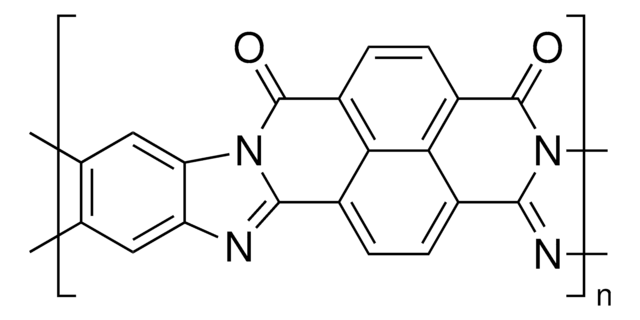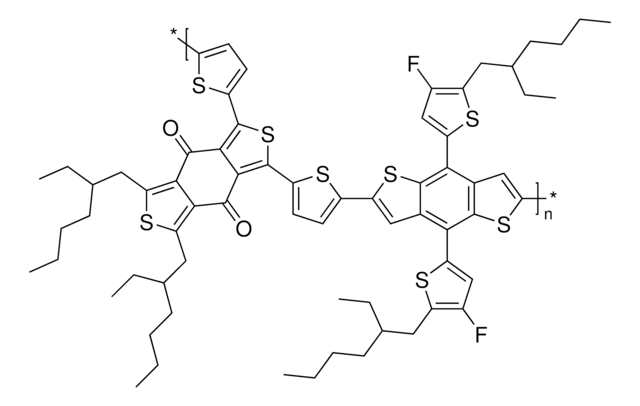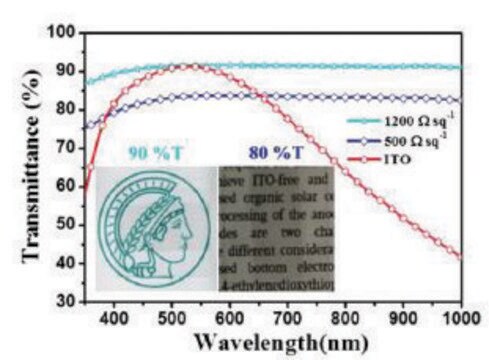Kluczowe dokumenty
932647
n-Type BBL:PEI ink
butanol-based
Synonim(y):
Farba poli(benzimidazobenzofenantrolinowa) z butanolem polietylenoiminowym, n-ink-40-1-B
About This Item
Polecane produkty
opis
Thermal stability (1h in N2): Up to 350 °C
Poziom jakości
skład
butanol (solvent)
praca wyjścia
4.22 eV, UPS analysis
przewodność
((in plane): Up to 5 S/cm)
((out of plane): Up to 0.1 S/cm)
λmaks.
350 nm±5 nm
600 nm±5 nm
Zastosowanie
Jest kompatybilny z metodami osadzania na dużą skalę, takimi jak powlekanie natryskowe i atramentowe. Atrament BBL:PEI może być dalej rozcieńczany w celu odlewania cienkich warstw o różnej grubości. Cienkie warstwy BBL:PEI zostały wytworzone przez odlewanie natryskowe w powietrzu, a następnie wyżarzanie w temperaturze 140 °C przez 2 godziny w komorze rękawicowej wypełnionej azotem lub w próżni w celu wytworzenia warstw przewodzących. Atrament BBL:PEI po przetworzeniu tworzy warstwę typu n o wysokiej przewodności elektronowej, która może być stosowana jako warstwa przewodząca w ogniwach słonecznych, generatorach termoelektrycznych, diodach elektroluminescencyjnych lub aplikacjach logicznych:
- OPV - Warstwa odprowadzająca ładunek w organicznych ogniwach słonecznych
- Superkondensatory - Negatroda w organicznych superkondensatorach
- OECT - materiał aktywny w organicznych tranzystorach elektrochemicznych
- OLED - Warstwa wstrzykująca ładunek w organicznych diodach elektroluminescencyjnych
Uwaga dotycząca przygotowania
- Tusz należy zawsze przechowywać w ciemności i w temperaturze otoczenia.
- Należy energicznie wstrząsnąć butelką, aby zapewnić optymalne rozproszenie atramentu przed jego przetworzeniem (na przykład za pomocą kąpieli ultradźwiękowej; 100 do 300 W przez 30 minut).
- Atrament jest przeznaczony przede wszystkim do natryskiwania za pomocą pistoletu pneumatycznego lub podobnych metod natryskiwania.
- Folie są stabilne w powietrzu do 2 dni przed aktywacją termiczną.
- Aktywację termiczną atramentu należy zawsze przeprowadzać w środowisku obojętnym (próżnia, N2, Ar itp.) lub po odpowiednim zamknięciu w stabilnym związku.
- Chloroform, chlorobenzen, 1,8-dijodooktan, dimetyloformamid i sulfotlenek dimetylu nie mają wpływu na aktywowane termicznie folie naszych farb drukarskich.
Hasło ostrzegawcze
Danger
Zwroty wskazujące rodzaj zagrożenia
Zwroty wskazujące środki ostrożności
Klasyfikacja zagrożeń
Acute Tox. 4 Oral - Eye Dam. 1 - Flam. Liq. 3 - Skin Irrit. 2 - Skin Sens. 1 - STOT SE 3
Organy docelowe
Central nervous system, Respiratory system
Kod klasy składowania
3 - Flammable liquids
Klasa zagrożenia wodnego (WGK)
WGK 2
Temperatura zapłonu (°F)
95.0 °F
Temperatura zapłonu (°C)
35 °C
Wybierz jedną z najnowszych wersji:
Certyfikaty analizy (CoA)
It looks like we've run into a problem, but you can still download Certificates of Analysis from our Dokumenty section.
Proszę o kontakt, jeśli potrzebna jest pomoc Obsługa Klienta
Masz już ten produkt?
Dokumenty związane z niedawno zakupionymi produktami zostały zamieszczone w Bibliotece dokumentów.
Nasz zespół naukowców ma doświadczenie we wszystkich obszarach badań, w tym w naukach przyrodniczych, materiałoznawstwie, syntezie chemicznej, chromatografii, analityce i wielu innych dziedzinach.
Skontaktuj się z zespołem ds. pomocy technicznej






![[6,6]-Phenyl C61 butyric acid methyl ester ≥99%](/deepweb/assets/sigmaaldrich/product/structures/359/221/d990c746-0960-4c69-bf76-fe09b193824d/640/d990c746-0960-4c69-bf76-fe09b193824d.png)




